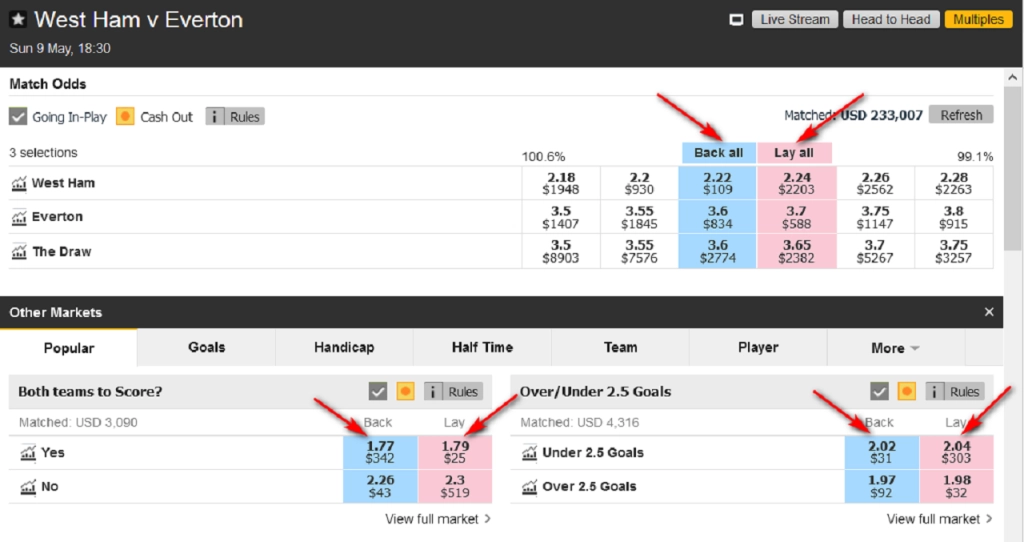
 Back and Lay Betting-Main
Back and Lay Betting-Main ব্যাক এবং লে বেটিং বোঝা
এখন সময় এসেছে ব্যাক অ্যান্ড লে বেটিং-এর গতিশীল জগতে প্রবেশ করার—একটি বহুমুখী কৌশল যা আপনার বেটিং পারফরম্যান্সকে উল্লেখযোগ্যভাবে উন্নত করার সম্ভাবনা প্রদান করে। এই কৌশলটি বোঝার মাধ্যমে, আপনি আপনার বেট থেকে সর্বাধিক মূল্য অর্জনের জন্য নিজেকে অবস্থানে রাখতে পারেন এবং প্রতিযোগিতায় এগিয়ে থাকতে পারেন।
ব্যাক অ্যান্ড লে বেটিং জ্ঞানী বাজিকরদের মধ্যে জনপ্রিয় কৌশল হিসেবে আবির্ভূত হয়েছে কারণ এর সম্ভাবনা বেশি, অর্থের মূল্য বৃদ্ধি পায় এবং ম্যাচ বেটিং এর মাধ্যমে লাভ অর্জনের সম্ভাবনা বেশি। আসুন সাফল্যের জন্য প্রস্তুত থাকার জন্য ব্যাক অ্যান্ড লে বেটিং এর জগতে আরও গভীরভাবে ডুব দেই।

Back and Lay Guide
বেটিং এক্সচেঞ্জ এবং তাদের কার্যক্রমের রহস্য উদঘাটন
বেটিং এক্সচেঞ্জগুলি ঐতিহ্যবাহী স্পোর্টসবুকের বিকল্প প্রদানের মাধ্যমে ক্রীড়া বাজির দৃশ্যপটকে বদলে দিয়েছে। বিশ্বের প্রথম বেটিং এক্সচেঞ্জ, বেটফেয়ার, এই বিপ্লবের নেতৃত্ব দিয়েছে, যা বাজিকরদের বুকমেকারের ভূমিকা গ্রহণের অনন্য সুযোগ প্রদান করেছে।
মূলত, একটি বেটিং এক্সচেঞ্জ হল এমন একটি মার্কেটপ্লেস যেখানে বাজি ধরতে পারে এবং বাজি ধরতে পারে। আপনি একটি নির্দিষ্ট ফলাফলের জন্য (বাজি ধরুন যে এটি ঘটবে) বা একই ফলাফলের জন্য (বাজি ধরুন যে এটি ঘটবে না) বেছে নিতে পারেন। এই সিস্টেমটি আপনাকে একজন ঐতিহ্যবাহী বাজিকর থেকে একজন বুকমেকারে ভূমিকা পরিবর্তন করতে দেয়।
যদিও বেটিং এক্সচেঞ্জ এবং স্পোর্টসবুকের মধ্যে মিল রয়েছে, তবে এটি বোঝা গুরুত্বপূর্ণ যে তারা মৌলিকভাবে আলাদা। ঐতিহ্যবাহী স্পোর্টসবুকগুলি কম দক্ষ সম্ভাবনা প্রদান করে লাভ করে; কোনও ইভেন্টের সমস্ত ফলাফল কভার করা হলেও, হাউস সর্বদা জয়ী হয়। বিপরীতে, বেটিং এক্সচেঞ্জগুলি অপারেটরের পরিবর্তে বাজি ধরার জন্য বাজি ধরতে সক্ষম করে, যেখানে এক্সচেঞ্জগুলি বাজি জেতার কমিশনের মাধ্যমে রাজস্ব আয় করে।
বাজি ধরা এবং রাখার কৌশল
স্পোর্টসবুক শতাব্দীর পর শতাব্দী ধরে প্রচলিত এবং তাদের সহজ-সরল অপারেটিং মডেলের কারণে জনপ্রিয়। বাজি ধরার জন্য বাজি ধরার খেলোয়াড়রা কোনও ম্যাচ বা দৌড়ের ফলাফলের উপর বাজি ধরে। বাজি ধরার খেলোয়াড় জিতলে, স্পোর্টসবুক হেরে যায় এবং বিপরীতভাবে। স্পোর্টসবুক নিশ্চিত করে যে তারা প্রায়শই তাদের পক্ষে সম্ভাবনা প্রদান করে শীর্ষে আসে।
বেটিং এক্সচেঞ্জের মাধ্যমে, আপনি বাজি ধরতে এবং বাজি ধরতে উভয়ই পারেন, যা কার্যকরভাবে আপনাকে বুকমেকারের ভূমিকা গ্রহণ করতে দেয়। বিনিময়টি ব্যাকার এবং লেয়ারের মধ্যে একটি দালাল হিসাবে কাজ করে। একটি বাজি শুরু করার জন্য, একজন ব্যাকারকে একটি ফলাফল সমর্থন করতে হবে এবং একটি লেয়ারকে একই ফলাফল রাখতে হবে। বাজি গ্রহণের আগে উভয় পক্ষকে অডস এবং বাজির উপর একমত হতে হবে।
যখন আপনি বাজি ধরেন, তখন আপনি একটি নির্দিষ্ট ফলাফলের বিরুদ্ধে বাজি ধরছেন। মূলত, আপনি আপনার টাকা বাজি ধরছেন যে একটি নির্দিষ্ট ঘটনা ঘটবে না। এটা মনে রাখা গুরুত্বপূর্ণ যে আপনি যেকোনো কিছুর উপর বাজি ধরতে পারলেও, অন্য কোনও খেলোয়াড় এটি সমর্থন করতে ইচ্ছুক হবে এমন কোনও গ্যারান্টি নেই।
বাজি ধরার জন্য একটি ব্যবহারিক নির্দেশিকা
বাজি ধরার প্রক্রিয়াটি একটি উদাহরণ দিয়ে সবচেয়ে ভালোভাবে ব্যাখ্যা করা যায়। নাপোলি এবং রেড বুল সালজবার্গের মধ্যে চ্যাম্পিয়ন্স লিগের একটি খেলার কথা বিবেচনা করুন। নাপোলি তাদের ঘরের মাঠে দুর্দান্ত পারফর্মেন্সের জন্য পরিচিত, তাই আপনি তাদের হার না হারাতে সাহায্য করতে পারেন।
ঐতিহ্যবাহী স্পোর্টসবুকে গিয়ে নাপোলি/ড্র-তে ডাবল-চান্স বাজি ধরার পরিবর্তে, আরও লাভজনক বিকল্প হতে পারে রেড বুল সালজবার্গকে একটি বেটিং এক্সচেঞ্জে রাখা।
এটি করার জন্য, আপনাকে রেড বুল সালজবার্গের সাথে সম্পর্কিত 'লে' কলামে ক্লিক করতে হবে। সম্ভাবনা হল এই দলকে সমর্থনকারী বাজিকরদের দেওয়া অডস, এবং সম্ভাবনার নীচে আপনি যে সংখ্যাটি দেখতে পাচ্ছেন তা হল রেড বুল সালজবার্গে বাজি ধরা পরিমাণ।
আপনি যে পরিমাণ অর্থ জিততে পারবেন তা সমর্থকদের বাজির পরিমাণের সমান। আপনি যে পরিমাণ অর্থ জিততে চান তা বেছে নিতে পারেন, যা সমর্থকদের বাজির চেয়ে বেশি বা কম হতে পারে।

What is Lay and Back in Betting
ঝুঁকি হ্রাস
বাজি ধরার সাথে সম্পর্কিত ঝুঁকির কারণে, একটি কার্যকর ঝুঁকি-ব্যবস্থাপনা কৌশল থাকা অত্যন্ত গুরুত্বপূর্ণ। উদাহরণস্বরূপ, উপরের উদাহরণে, রেড বুল সালজবার্গ জিতলে আপনি একটি উল্লেখযোগ্য পরিমাণ হারাতে পারেন। এই দায়টি এইভাবে গণনা করা যেতে পারে:
(অডস লে - ১) * আপনার বাজি।
তাই যদি আপনি রেড বুল সালজবার্গকে ৫.০ এর ব্যবধানে ১০ ডলারের শেয়ার দিয়ে দেন, তাহলে আপনার দায় হল:
(5.0 - 1) * $10 = $40.
এর মানে হল, যদি রেড বুল সালজবার্গ জিততে পারে, তাহলে আপনি ৪০ ডলার হারাবেন। যদি তারা না জিততে পারে, তাহলে আপনি ১০ ডলার জিতবেন।
ঝুঁকি পরিচালনা করতে, আপনি নিম্নলিখিত কৌশলগুলি ব্যবহার করতে পারেন:
- আপনার দায়বদ্ধতা পরিচালনাযোগ্য রাখুন: এমন একটি দায়বদ্ধতা নিয়ে বাজি ধরার পরামর্শ দেওয়া হয় যা আপনি হারাতে পারেন। এটি একটি একক বাজিতে আপনার ব্যাংকরোল মুছে ফেলার ঝুঁকি হ্রাস করে।
- আপনার বাজি ধরে রাখুন: হেজিংয়ের মধ্যে সম্ভাব্য ক্ষতি সীমিত করার জন্য বিভিন্ন ফলাফলের উপর বাজি ধরা অন্তর্ভুক্ত। এর মধ্যে একটি স্পোর্টসবুকে একটি ফলাফলকে সমর্থন করা এবং তারপরে একই ফলাফল একটি বাজি বিনিময়ে স্থাপন করা অন্তর্ভুক্ত থাকতে পারে।
- বাজারকে বুঝুন: খেলার গতিশীলতা এবং জড়িত দলগুলি যত বেশি বুঝবেন, ততই আপনি সুনির্দিষ্টভাবে বাজি ধরার সিদ্ধান্ত নেওয়ার জন্য উপযুক্ত অবস্থানে থাকবেন।
- একটি ম্যাচিং বেটিং কৌশল ব্যবহার করুন: ম্যাচড বেটিংয়ের মধ্যে একই ফলাফলের উপর বাজি ধরা এবং মুনাফা অর্জন করা অন্তর্ভুক্ত। নীতি হল স্পোর্টসবুক কর্তৃক প্রদত্ত বিনামূল্যের বাজি এবং বোনাস ব্যবহার করে একটি ইভেন্টের সমস্ত ফলাফলের উপর বাজি ধরা, যার ফলে ফলাফল নির্বিশেষে লাভ নিশ্চিত করা।
ব্যাক এবং লে বেটিংয়ে আরবিট্রেজের ভূমিকা
আরবিট্রেজ হল একটি আর্থিক শব্দ যা ঝুঁকিমুক্ত মুনাফা নিশ্চিত করার জন্য বিভিন্ন বাজারে মূল্যের পার্থক্যকে কাজে লাগানোর অনুশীলনকে বোঝায়। এই নীতিটি ব্যাক অ্যান্ড লে বেটিং প্রক্রিয়ার মাধ্যমে ক্রীড়া বাজির ক্ষেত্রে প্রয়োগ করা যেতে পারে।
ক্রীড়া বাজির জগতে, যখন আপনি আপনার সম্ভাব্যতার চেয়ে বেশি প্রতিকূলতার সাথে কোনও ফলাফলকে সমর্থন করতে পারেন তখন একটি সালিসি সুযোগ তৈরি হয়। ফলাফল যাই হোক না কেন, এটি লাভের নিশ্চয়তা দেয়।
আরবিট্রেজ বেটিং, বা 'আরবিং'-এর মধ্যে একটি বেটিং এক্সচেঞ্জ এবং একটি স্পোর্টসবুক ব্যবহার করা জড়িত। আপনি একটি স্পোর্টসবুকের ফলাফলকে উচ্চ প্রতিকূলতার সাথে সমর্থন করেন এবং তারপরে একই ফলাফল কম প্রতিকূলতার সাথে একটি বেটিং এক্সচেঞ্জের উপর রাখেন। প্রতিকূলতার মধ্যে বৈষম্য আপনাকে লাভ লক করতে দেয়।
আরবিং-এর জন্য অনেক সময় এবং প্রচেষ্টার প্রয়োজন হয় এবং এর ঝুঁকিও কম নয়। বুকমেকাররা যদি আপনার আরবিং সন্দেহ করে তবে তারা আপনার অ্যাকাউন্ট সীমিত বা বন্ধ করে দিতে পারে। কিন্তু, সঠিকভাবে করা হলে, এটি একটি স্থিতিশীল, যদিও ছোট, লাভের ধারা প্রদান করতে পারে।

Back and Lay in Cricket Betting
উপসংহার
ব্যাক অ্যান্ড লে বাজি কৌশলগুলি খেলাধুলায় বাজি ধরার একটি উদ্ভাবনী উপায় প্রদান করে। এই কৌশলগুলির পিছনের প্রক্রিয়াগুলি এবং কীভাবে কার্যকরভাবে ঝুঁকি হ্রাস করা যায় তা বোঝার মাধ্যমে, আপনি সম্ভাব্যভাবে আপনার বাজি থেকে একটি স্থির লাভের ধারা নিশ্চিত করতে পারেন।
মনে রাখবেন, যদিও সাধারণ বাজি বেশি লাভের সম্ভাবনা রাখে, তবুও এর সাথে ঝুঁকিও বেশি থাকে। সকল ধরণের বাজির মতো, এই কৌশলগুলিও দায়িত্বের সাথে ব্যবহার করা উচিত। সর্বদা আপনার সামর্থ্যের মধ্যে বাজি ধরুন এবং প্রক্রিয়াটি উপভোগ করতে ভুলবেন না!
প্রায়শই জিজ্ঞাসিত প্রশ্নাবলী
ব্যাক অ্যান্ড লে বেটিং কী?
ব্যাক অ্যান্ড লে বেটিং হল একটি বাজির কৌশল যার মধ্যে একই ইভেন্টে দুটি বিপরীত বাজি ধরা হয়। একটি ব্যাক বেট ভবিষ্যদ্বাণী করে যে একটি ফলাফল ঘটবে, অন্যদিকে একটি লে বেট ভবিষ্যদ্বাণী করে যে একই ফলাফল ঘটবে না।
লে বেটিং এর সাথে সম্পর্কিত ঝুঁকিগুলি আমি কীভাবে কমাতে পারি?
সাধারণ বাজিতে ঝুঁকি পরিচালনার জন্য বেশ কয়েকটি কৌশল রয়েছে, যার মধ্যে রয়েছে আপনার দায়বদ্ধতা পরিচালনাযোগ্য রাখা, আপনার বাজি হেজিং করা, বাজার বোঝা এবং একটি মিলিত বাজি কৌশল ব্যবহার করা।
ব্যাক অ্যান্ড লে বেটিং এর প্রেক্ষাপটে আরবিট্রেজ কী?
আরবিট্রেজ, বা 'আর্বিং', ইন ব্যাক অ্যান্ড লে বেটিং হল এমন একটি কৌশল যেখানে আপনি বিভিন্ন বুকমেকারদের দ্বারা প্রদত্ত সম্ভাবনার পার্থক্যকে কাজে লাগিয়ে ঝুঁকিমুক্ত মুনাফা নিশ্চিত করেন। এর মধ্যে রয়েছে একটি স্পোর্টসবুকের ফলাফলকে উচ্চতর সম্ভাবনার ভিত্তিতে সমর্থন করা এবং তারপরে একই ফলাফলকে কম সম্ভাবনার ভিত্তিতে একটি বেটিং এক্সচেঞ্জে স্থাপন করা।